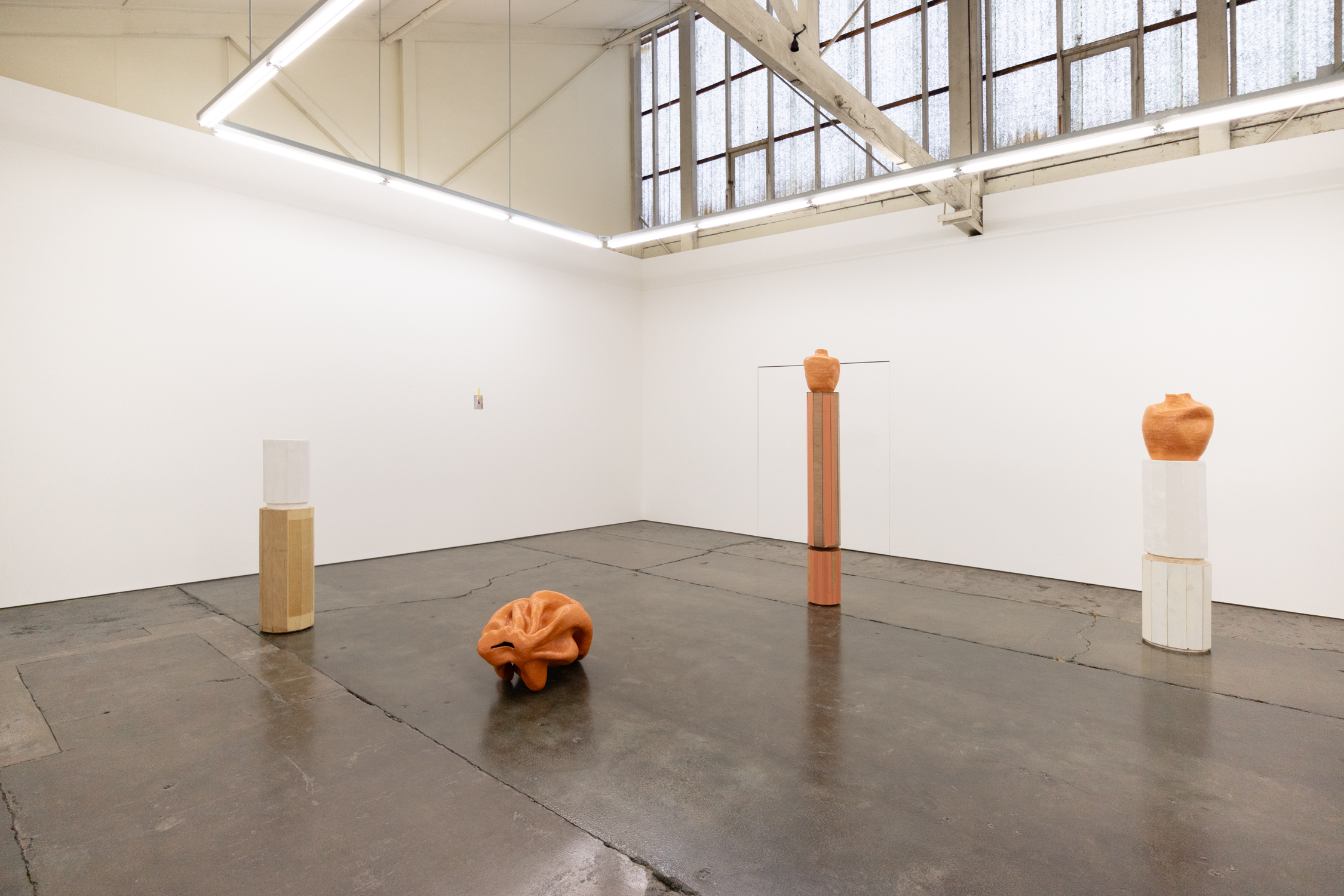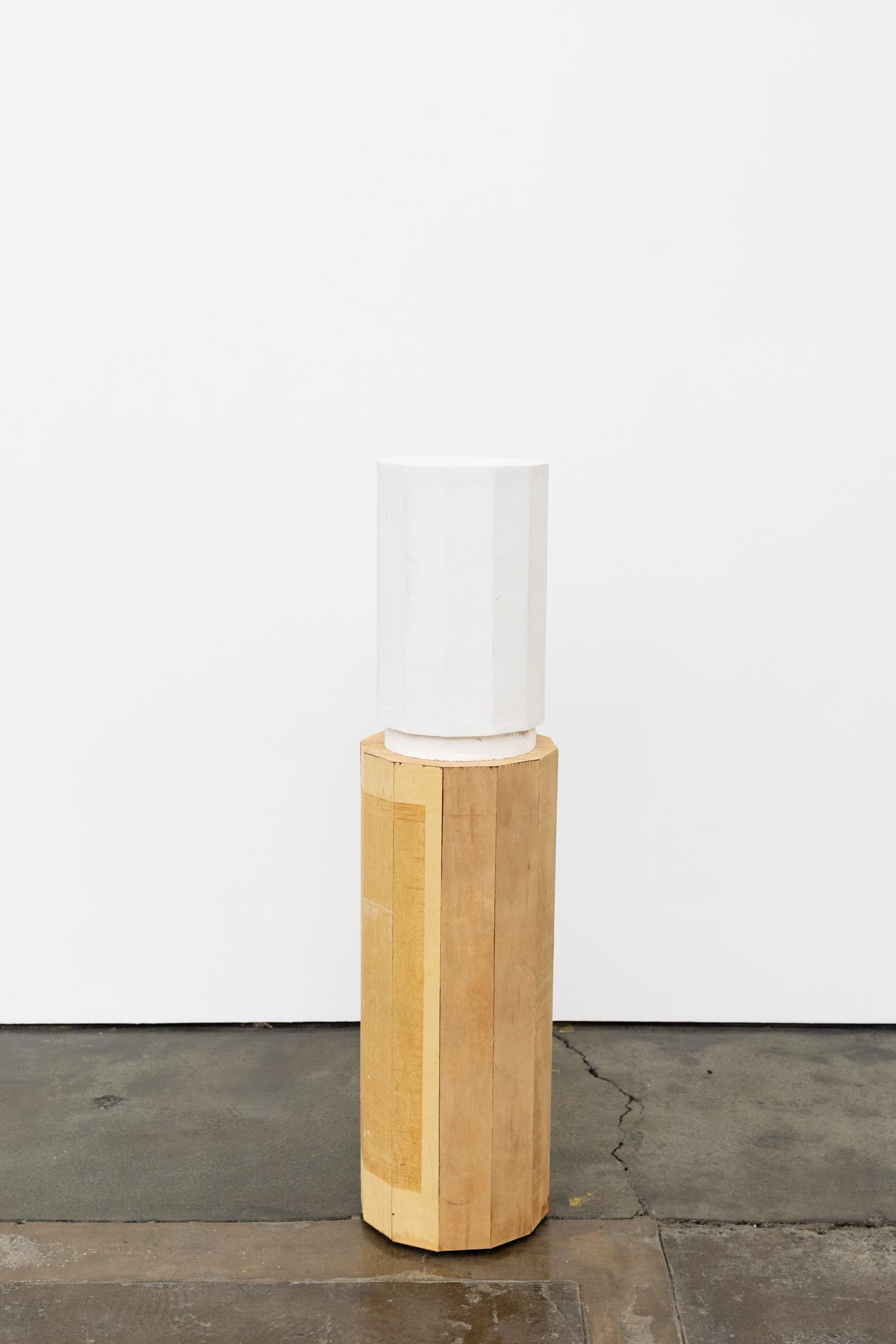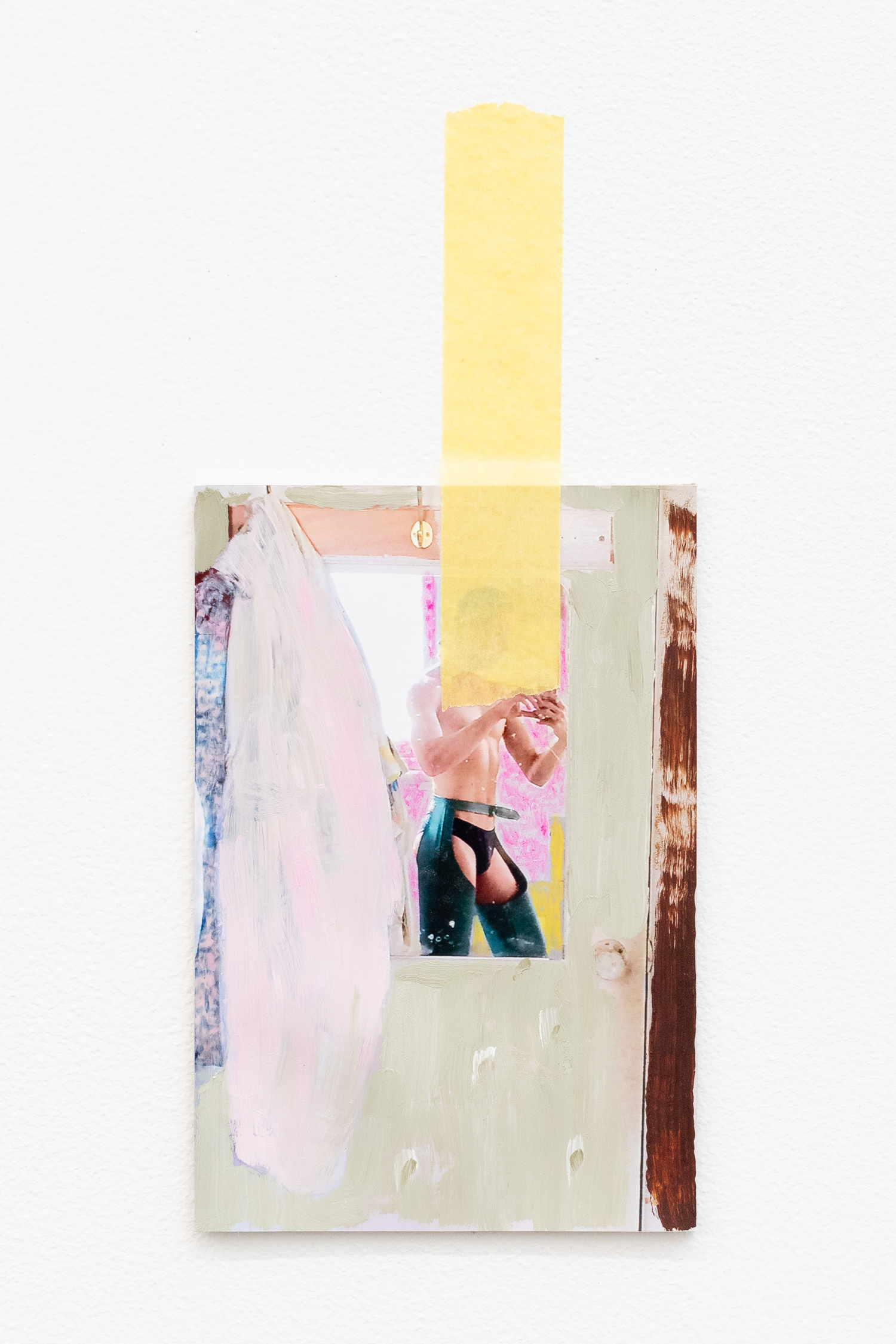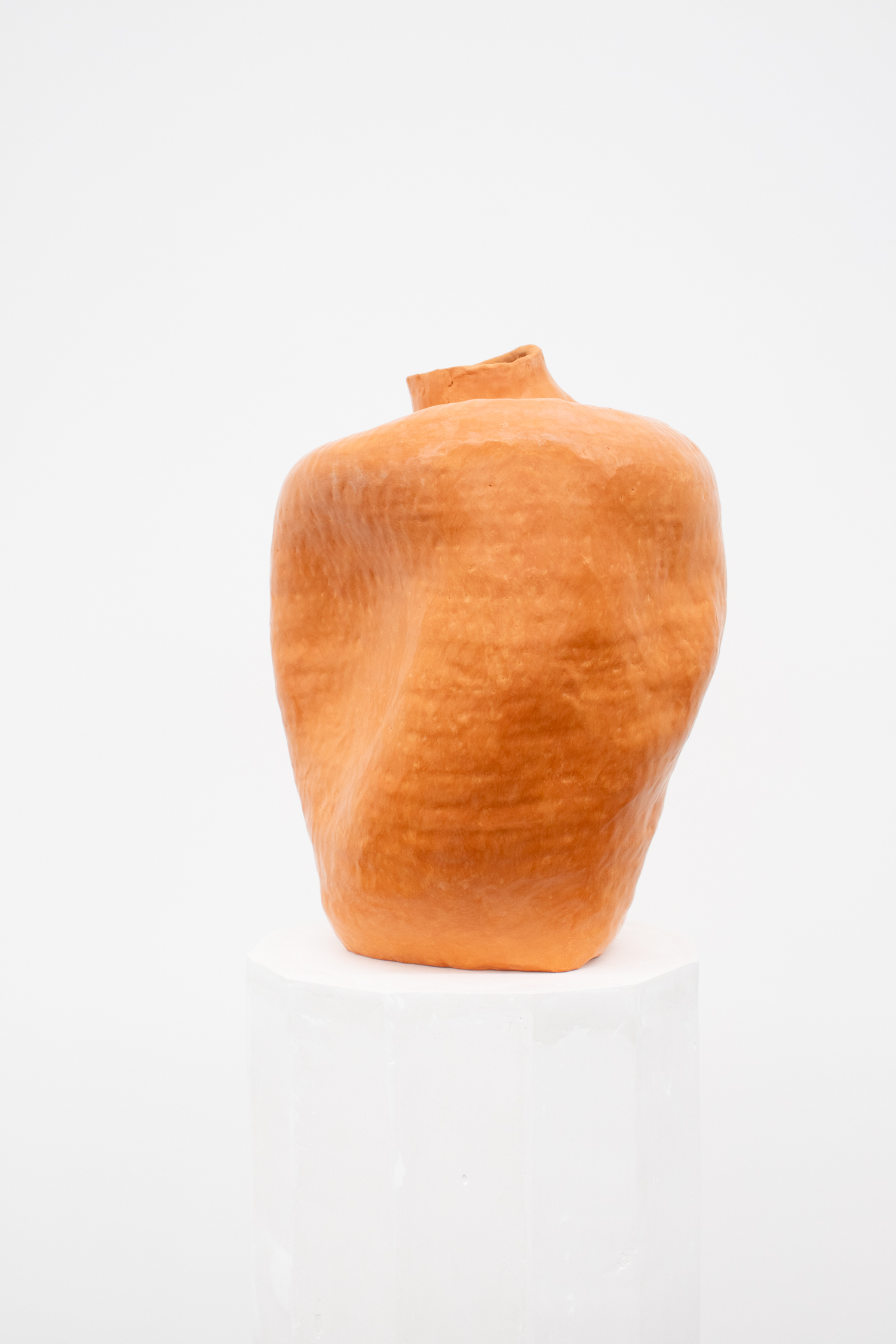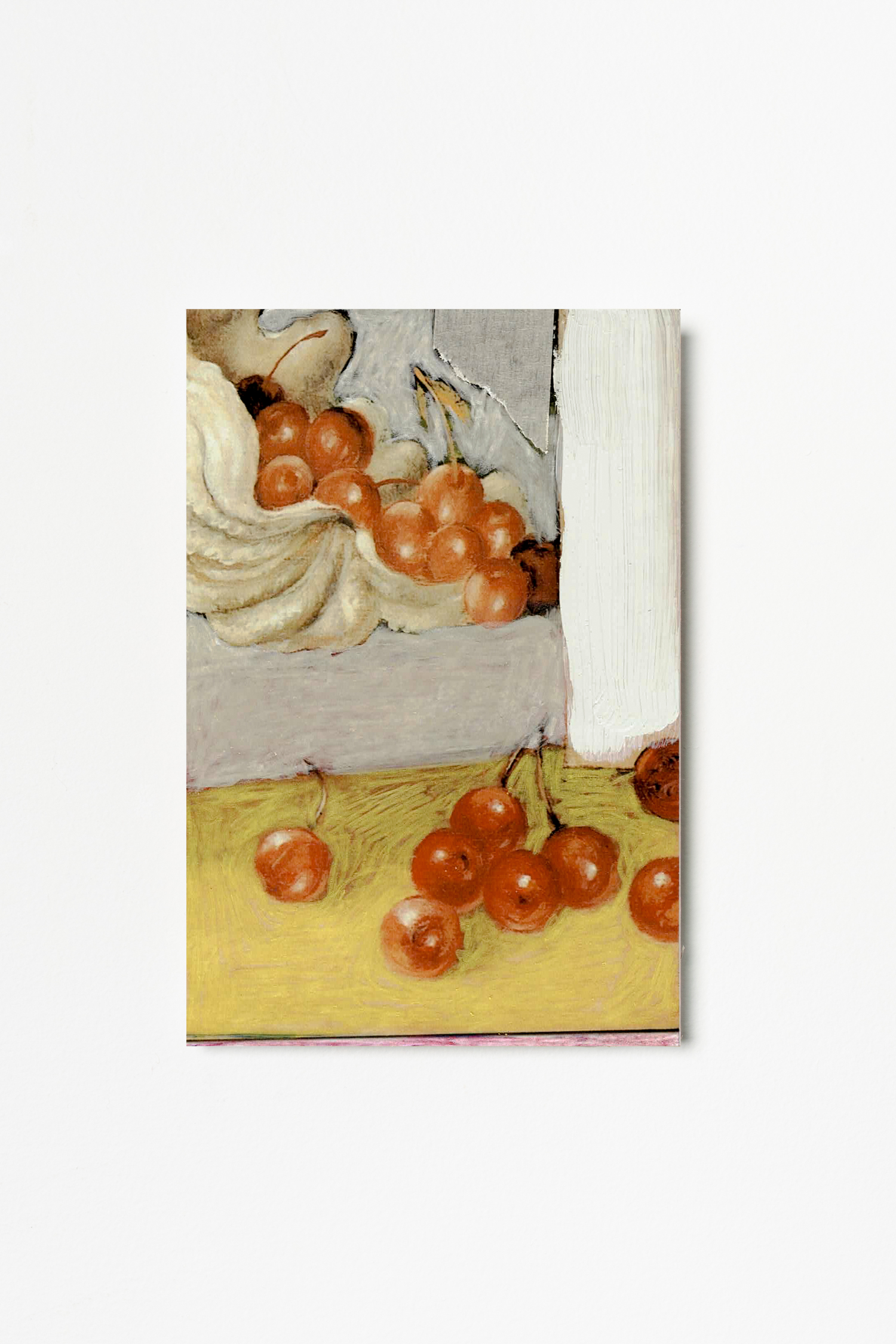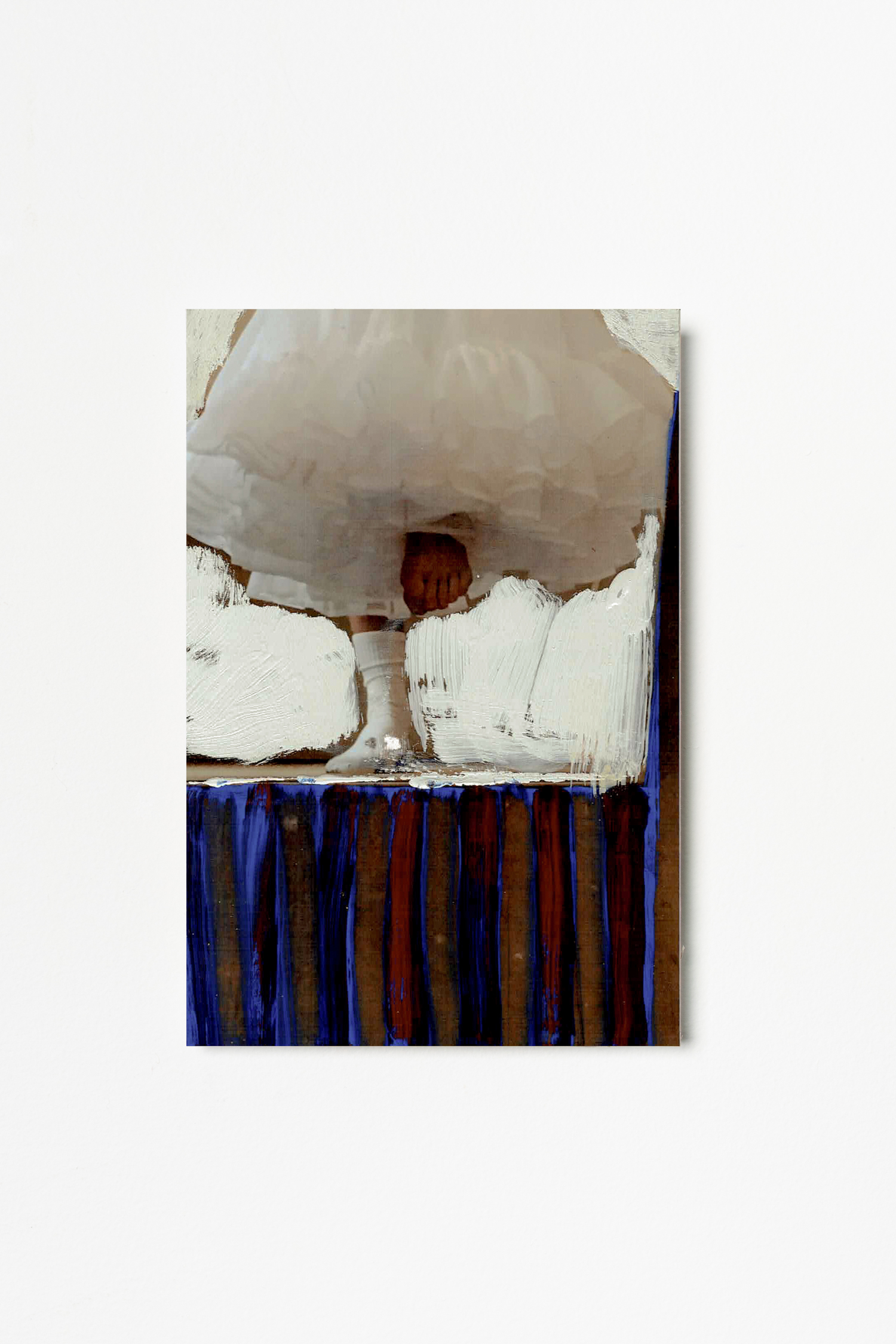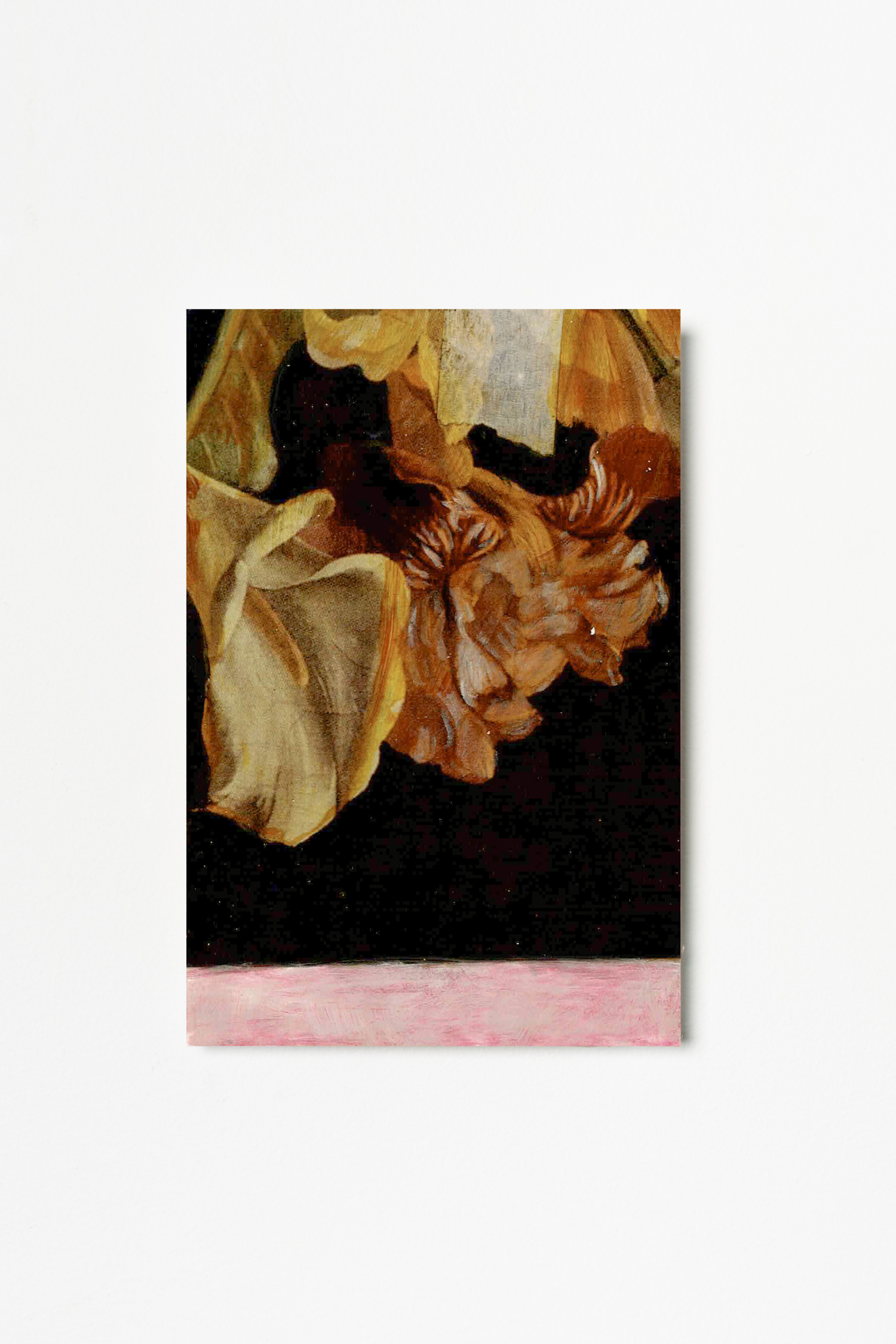Nicholas Smith
10.11.2023 - 09.12.2023
Haydens presents Idols,
an exhibition of new ceramic sculptures by Nicholas Smith. Situated within an
expansive installation featuring a large textile hanging of lurid automotive
vinyl upholstery and upcycled timber plinths made from abandoned artworks, Idols explores complex moments of
personal and collective repression through a queer methodology.
By dividing the gallery in two via a suspended backdrop akin to his work decorator’s touch as part of The National 4: Australian Art Now at MCA, Nicholas creates an immersive environment that challenges notions of public and private. This environment serves to frame the ceramic works, allowing their reading to oscillate between the languages of sculpture, décor, and prop. Using domestic materials and palettes, drawn from the artist’s regional suburban upbringing, we can begin to unpack the libidinous undertones that inform his queer identity.
Nicholas Smith investigates sexuality, identity and memory in his works, often employing diverse media including ceramics and found materials. In 2022 he graduated with a Masters of Fine Art from ArtCenter College of Design, Los Angeles. His works have been included in major exhibitions including The National 4: Australian Art Now, Museum of Contemporary Art Australia, Sydney (2023); and Queer: Stories from the NGV Collection, National Gallery of Victoria, Melbourne (2022). His recent solo shows include: Ribbons and Piss, ArtCenter MFA Thesis Exhibition, Los Angeles (2022); Cooled pride, roused ardour, Bus Projects, Melbourne (2018); I am crying, in collaboration with Jimmy Nuttall, Firstdraft, Sydney (2017); Swaddle me, West Space, Melbourne (2016); and Feint Understanding, TCB Art Inc., Melbourne (2015). In 2019 he was awarded the American Friends of the National Gallery of Australia AusArt Fellowship in support of his education in California. His work is held in the National Gallery of Victoria’s collection.
Feint understanding
Olivia Koh
A person called Adrian wakes up, pats his dog who has jumped on the bed, goes to the toilet. He cleans some piss that has dripped onto the toilet seat, washes his hands in the small sink in the laundry. He walks to the kitchen, to the stove, packs some ground coffee beans into a percolator to the rim, some grounds fall onto the bench and he wipes them off, they stick on the synthetic cloth, small brown dots against blue and white stripes. Adrian lights the stove burner, places the percolator on to boil, noticing a piece of white A4 paper lying face down on the counter top. While the percolator boils he turns the paper over to find a small excerpt typed on the page, he reads:
Adrian’s boyfriend is an art historian and Adrian assumes this sheet has gone astray from a larger draft, the last sentence has been partially crossed out and he cannot make out the ending. He carefully turns the paper back to its blank side, the words facing down, picks up some empty ceramic mugs and hangs them from their handles from some metal hooks he installed yesterday, they rock slightly back and forth a bit on the hangers but their bodies do not touch. Adrian sighs but does not notice, he is given to sighing quite frequently, as he is occasionally told by friends, he forgets this habit unless someone comments on it. He heard a kind of explanation or theory that sighing was a way to rid the body of ghosts and thought once this might be what he was doing, but promptly forgot it. Having grown up Catholic, Adrian unintentionally sought affinity with the mysticism of this explanation before later rejecting it. He wouldn’t like to admit it but part of him still believes in this explanation and part of him is back there in the moment that he heard it from someone, he doesn’t remember who. He tries to sigh less but there is no one around to hear him in the apartment so he doesn’t realise he is doing it. Adrian turns the stove burner to off and pours coffee into a mug which he will drink without milk. From the smell released from the coffee cup Adrian’s stomach does a small twinge of anticipation, the smell also rises into his head giving him a tiny numbness high up in his olfactory brain, but this is barely perceptible to the rest of his body standing in the kitchen, they are on the whole unregistered sensations.
Adrian sits on the couch he brought over from his mum’s house, an old green vinyl reupholstered from car seats, he always liked making new things from other older things, how someone would ask him how did you do that, what was it made from again, how he would give something a new life in a different form that might otherwise be discarded or forgotten. More recently this action of remaking has become a trend and now Adrian knows this couch would be considered with the labels mid-century or vintage furniture and traded for money, along with the curtains he sewed to make pillows for the couch, fabric his mum received as a wedding gift a long time ago. Adrian likes how his back cannot really sink into the couch, how the backboard, padding and vinyl resist his weight and push against it, keeping him more firmly upright, it reminds him of long car rides where his body would try to slump against the backseat, trying to get comfortable, wanting to sleep but his eyes in a battle with the road, the moving trees and the light, wanting to stay awake to see.
Adrian is redecorating the apartment, his hands push aside paint swatches in terracotta and pinks that are resting on the brown coffee table under a vase of flowers, Adrian picked them from his part-time gardening job along with wildflowers from an empty lot; red, yellow, mauve, he occasionally uses the swatches as bookmarks for a play he is reading. There are only two characters in the play and they engage in lengthy, impassioned monologues; one is called the Dealer, one is called the Client, but all other discerning information about the characters so far remains unknown.2 Adrian enjoys how high the stakes are, how the character’s titles fold the specificity of what gender they are, where they are from, their wealth and culture, into larger universals, a push and pull between two, an answer and another response, and even though the piece was written a long time ago it can be applicable to something both grand and base, maybe what would be considered human nature. So far the characters have not found any answers to their questions, and Adrian is losing patience a little with the storyline, the characters so full of words seem to be missing each other’s points in their eloquent replies, can all interactions be reduced to these archetypes, to giving and receiving, marking and bearing, what could be considered as supply and demand, he sips coffee from a mug and his fingers are playing with a piece of green satin ribbon as he reads.
Seeing past these pages from his position on the couch, Adrian’s eyes catch the naked body of a neighbour in the next apartment block, across the way, a floor above his. The neighbour wraps a towel around themselves but their torso is still visible between the door frame, seen on an angle through the kitchen window. Adrian is still startled by this ability to see into people’s rooms and often he cannot easily look away. When he lived much further out from the city, such sudden apparitions were limited to glimpses of parts of an animal, like a kangaroo moving between the trees and paddocks by the window, or a mirror or piece of metal that had caught sunlight and happened to reflect it from outside, into the house.
Olivia Koh, November 2023
1Eaton, J (2023). The National 4 Australian Art Now [Exhibition catalogue]. Exhibited at Museum of Contemporary Art [decorator’s touch, Nicholas Smith, 31 March - 9 July 2023].
2 Koltès, Bernard-Marie. In the Solitude of Cotton Fields (Dans la solitude des champs de coton). Bloomsbury Methuen Drama, 2002.
By dividing the gallery in two via a suspended backdrop akin to his work decorator’s touch as part of The National 4: Australian Art Now at MCA, Nicholas creates an immersive environment that challenges notions of public and private. This environment serves to frame the ceramic works, allowing their reading to oscillate between the languages of sculpture, décor, and prop. Using domestic materials and palettes, drawn from the artist’s regional suburban upbringing, we can begin to unpack the libidinous undertones that inform his queer identity.
Nicholas Smith investigates sexuality, identity and memory in his works, often employing diverse media including ceramics and found materials. In 2022 he graduated with a Masters of Fine Art from ArtCenter College of Design, Los Angeles. His works have been included in major exhibitions including The National 4: Australian Art Now, Museum of Contemporary Art Australia, Sydney (2023); and Queer: Stories from the NGV Collection, National Gallery of Victoria, Melbourne (2022). His recent solo shows include: Ribbons and Piss, ArtCenter MFA Thesis Exhibition, Los Angeles (2022); Cooled pride, roused ardour, Bus Projects, Melbourne (2018); I am crying, in collaboration with Jimmy Nuttall, Firstdraft, Sydney (2017); Swaddle me, West Space, Melbourne (2016); and Feint Understanding, TCB Art Inc., Melbourne (2015). In 2019 he was awarded the American Friends of the National Gallery of Australia AusArt Fellowship in support of his education in California. His work is held in the National Gallery of Victoria’s collection.
Feint understanding
Olivia Koh
A person called Adrian wakes up, pats his dog who has jumped on the bed, goes to the toilet. He cleans some piss that has dripped onto the toilet seat, washes his hands in the small sink in the laundry. He walks to the kitchen, to the stove, packs some ground coffee beans into a percolator to the rim, some grounds fall onto the bench and he wipes them off, they stick on the synthetic cloth, small brown dots against blue and white stripes. Adrian lights the stove burner, places the percolator on to boil, noticing a piece of white A4 paper lying face down on the counter top. While the percolator boils he turns the paper over to find a small excerpt typed on the page, he reads:
…author Garth Greenwell expressed that queerness is a sensation that emerges from ‘affective allegiances and libidinal impulses,’ which constitute a ‘sufficient authority for the practice of art.’ Greenwell’s embodied understanding of queerness and the guiding authority of art resonates when considering1
Adrian’s boyfriend is an art historian and Adrian assumes this sheet has gone astray from a larger draft, the last sentence has been partially crossed out and he cannot make out the ending. He carefully turns the paper back to its blank side, the words facing down, picks up some empty ceramic mugs and hangs them from their handles from some metal hooks he installed yesterday, they rock slightly back and forth a bit on the hangers but their bodies do not touch. Adrian sighs but does not notice, he is given to sighing quite frequently, as he is occasionally told by friends, he forgets this habit unless someone comments on it. He heard a kind of explanation or theory that sighing was a way to rid the body of ghosts and thought once this might be what he was doing, but promptly forgot it. Having grown up Catholic, Adrian unintentionally sought affinity with the mysticism of this explanation before later rejecting it. He wouldn’t like to admit it but part of him still believes in this explanation and part of him is back there in the moment that he heard it from someone, he doesn’t remember who. He tries to sigh less but there is no one around to hear him in the apartment so he doesn’t realise he is doing it. Adrian turns the stove burner to off and pours coffee into a mug which he will drink without milk. From the smell released from the coffee cup Adrian’s stomach does a small twinge of anticipation, the smell also rises into his head giving him a tiny numbness high up in his olfactory brain, but this is barely perceptible to the rest of his body standing in the kitchen, they are on the whole unregistered sensations.
Adrian sits on the couch he brought over from his mum’s house, an old green vinyl reupholstered from car seats, he always liked making new things from other older things, how someone would ask him how did you do that, what was it made from again, how he would give something a new life in a different form that might otherwise be discarded or forgotten. More recently this action of remaking has become a trend and now Adrian knows this couch would be considered with the labels mid-century or vintage furniture and traded for money, along with the curtains he sewed to make pillows for the couch, fabric his mum received as a wedding gift a long time ago. Adrian likes how his back cannot really sink into the couch, how the backboard, padding and vinyl resist his weight and push against it, keeping him more firmly upright, it reminds him of long car rides where his body would try to slump against the backseat, trying to get comfortable, wanting to sleep but his eyes in a battle with the road, the moving trees and the light, wanting to stay awake to see.
Adrian is redecorating the apartment, his hands push aside paint swatches in terracotta and pinks that are resting on the brown coffee table under a vase of flowers, Adrian picked them from his part-time gardening job along with wildflowers from an empty lot; red, yellow, mauve, he occasionally uses the swatches as bookmarks for a play he is reading. There are only two characters in the play and they engage in lengthy, impassioned monologues; one is called the Dealer, one is called the Client, but all other discerning information about the characters so far remains unknown.2 Adrian enjoys how high the stakes are, how the character’s titles fold the specificity of what gender they are, where they are from, their wealth and culture, into larger universals, a push and pull between two, an answer and another response, and even though the piece was written a long time ago it can be applicable to something both grand and base, maybe what would be considered human nature. So far the characters have not found any answers to their questions, and Adrian is losing patience a little with the storyline, the characters so full of words seem to be missing each other’s points in their eloquent replies, can all interactions be reduced to these archetypes, to giving and receiving, marking and bearing, what could be considered as supply and demand, he sips coffee from a mug and his fingers are playing with a piece of green satin ribbon as he reads.
Seeing past these pages from his position on the couch, Adrian’s eyes catch the naked body of a neighbour in the next apartment block, across the way, a floor above his. The neighbour wraps a towel around themselves but their torso is still visible between the door frame, seen on an angle through the kitchen window. Adrian is still startled by this ability to see into people’s rooms and often he cannot easily look away. When he lived much further out from the city, such sudden apparitions were limited to glimpses of parts of an animal, like a kangaroo moving between the trees and paddocks by the window, or a mirror or piece of metal that had caught sunlight and happened to reflect it from outside, into the house.
Olivia Koh, November 2023
1Eaton, J (2023). The National 4 Australian Art Now [Exhibition catalogue]. Exhibited at Museum of Contemporary Art [decorator’s touch, Nicholas Smith, 31 March - 9 July 2023].
2 Koltès, Bernard-Marie. In the Solitude of Cotton Fields (Dans la solitude des champs de coton). Bloomsbury Methuen Drama, 2002.



